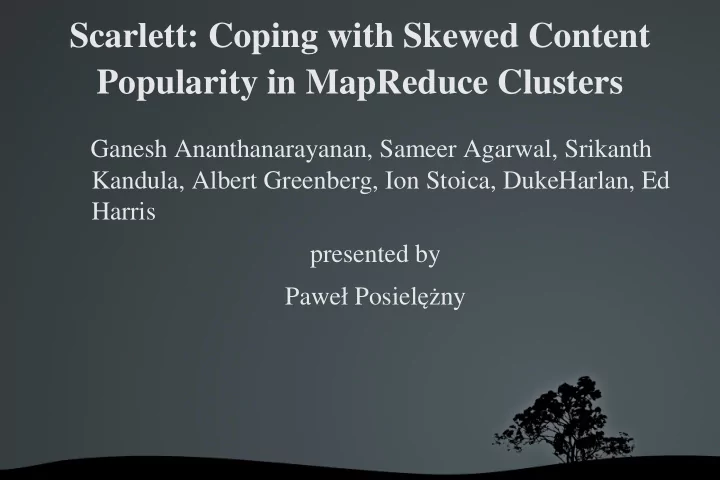

Scarlett: Coping with Skewed Content Popularity in MapReduce Clusters Ganesh Ananthanarayanan, Sameer Agarwal, Srikanth Kandula, Albert Greenberg, Ion Stoica, DukeHarlan, Ed Harris presented by Paweł Posielężny
MapReduce
Why Scarlett?
Scarlett uses historical usage statistics online predictors based on recent past information about the jobs that have been submitted for execution
the skew in popularity and its impact.
Effect of Popularity Skew: Hotspots
Logs summary The number of concurrent accesses is a sufficient metric to capture popularity of files. Large files contribute to most accesses in the cluster, so reducing contention for such files improves overall performance. Recent logs are a good indicator of future access patterns. Hotspots in the cluster can be smoothened via appropriate placement of files.
Scarlett: System Design Scarlett considers replicating content at the smallest granularity at which jobs can address content (file) Scarlett replicates files based on predicted popularity.
File Replication Factor maintains a count of the maximum number of concurrent accesses (cf) in a learningwindow of length TL Once every rearrangement period, TR, Scarlett computes appropriate replication factors for all the files. TL = 24 hours TR = 12 hours δ replication factor: rf = max(cf + , 3).
Scarlett employs two approaches. the priority approach roundrobin approach
Desirable properties Scarlett’s strategy Files that are accessed more frequently havemore replicas to smooth their load over. δ Together, , TR and TL track changes in file popularity while being robust to shortlived effects. Choosing appropriate values for the budget on extra storage B and the period at which replication factors change TR can limit the impact of Scarlett on the cluster.
Smooth Placement of Replicas place the desired number of replicas of a block on as many distinct machines and racks as possible while ensuring that the expected load is uniform across all machines and racks.
Smooth Placement of Replicas load factor for each machine lm The load factor for each rack – lr (the sum of load factors of machines in the rack) Each replica is placed on the the rack with the least load and the machine with the least load in that rack. Placing a replica increases both these factors by the expected load due to that replica (= cf/rf ).
Creating Replicas Efficiently While Replicating, Read From Many Sources Compress Data Before Replicating Lazy Deletion
Case Studies of Frameworks How to deal with a task that cannot run at the machine(s) that it prefers to run at? less preferred tasks can be evicted to make way the newly arriving task can be forced to run at a suboptimal location in the cluster one of the contending tasks can be paused until contention passes
Evictions in Dryad Evicted task is given a 30s notice period before being evicted. Of all tasks that began running on the cluster, 21.1% of them end up being evicted
Loss of Locality in Hadoop achieve only 5% node locality and 59% rack locality. (data from Facebook's Hadoop's logs)
Evaluation Methodology: using an implementation of Hadoop using an extensive simulation of Dryad sensitivity analysis budget size and distribution compression techniques
Does data locality improve in Hadoop? δ = 1 TL range from 6 to 24 hours TR ≥ 10 hours B = 10% completion times of 500 jobs.
Is eviction of tasks prevented in Dryad? δ = 1 TL range from 6 to 24 hours TR = 12 hours B = 10%
Sensitivity Analysis
Storage Budget for Replication
Increase in Network Traffic
Benefits from selective replication
Summary Scarlett uses: historical usage statistics Scarlett uses online predictors based on recent past Scarlett uses information about the jobs that have been submitted for execution Scarlett replicates files based on predicted popularity.
Thank you
Any questions?
Recommend
More recommend